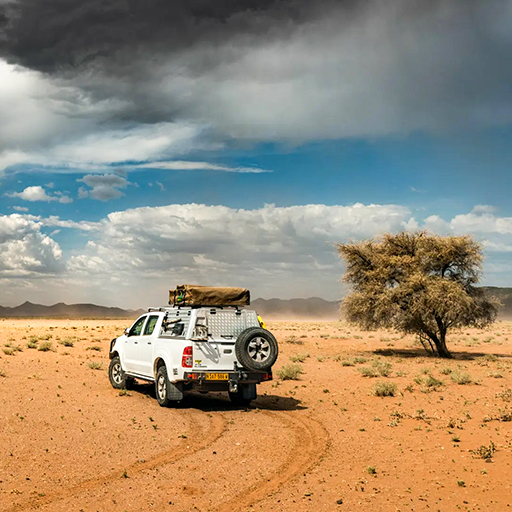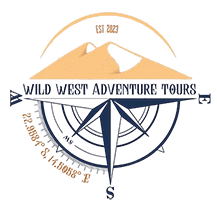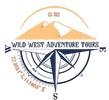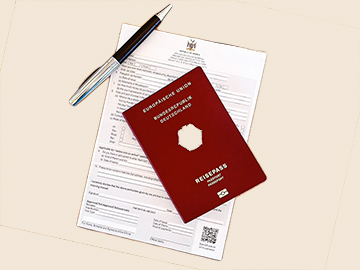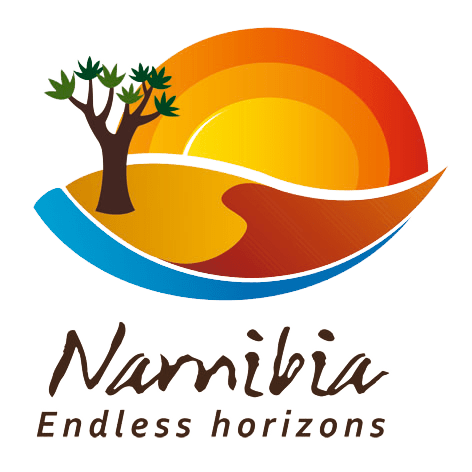Welcome to Wild West Adventure Tours – Your Gateway to Namibia’s Natural Wonders
Since 2023, we’ve been crafting unforgettable adventures in Namibia’s most stunning landscapes. Specializing in **Sandwich Harbour tours** and **Walvis Bay excursions**, we offer many other immersive, thrilling experiences that showcase the raw beauty of Namibia’s coastline.
Ready to explore? Book your Namibian adventure with us today!

Popular Destinations & Tours
Click Image for more Info
Walvis Bay - Swakopmund
Exploring Swakopmund & Walvis Bay: Adventure and Relaxation in Namibia’s Coastal Gems
Namibia’s charming coastal towns, Swakopmund and Walvis Bay, offer a unique blend of thrilling adventures, stunning landscapes, and rich cultural experiences. Whether you're an adrenaline junkie, a nature lover, or a food enthusiast, these towns provide unforgettable activities against the backdrop of the Atlantic Ocean and the Namib Desert.
Adventure & Outdoor Activities
-
Quad Biking & Sandboarding in the Namib Dunes
- Experience the thrill of racing across towering sand dunes on a quad bike or try sandboarding (like snowboarding, but on sand!).
-
Kayaking with Seals in Walvis Bay
- Paddle through the calm waters of Walvis Bay on a kayaking tour and get up close with playful Cape fur seals, dolphins, and even whales (seasonal).
-
Skydiving Over the Desert & Ocean
- For the ultimate adrenaline rush, take a tandem skydive and enjoy breathtaking views of the desert meeting the Atlantic Ocean.
-
Scenic Flights & Hot Air Ballooning
- See the dramatic landscapes from above with a scenic flight over the Skeleton Coast or a serene hot air balloon ride at sunrise, offering panoramic views of dunes, ocean, and wildlife.
Wildlife & Nature Experiences
-
Dolphin & Whale Watching Cruises
- Join a boat cruise in Walvis Bay to spot dolphins, seals, pelicans, and (in season) southern right whales. Many tours include fresh oysters and sparkling wine for a luxurious touch.
-
Birdwatching at Walvis Bay Lagoon
- A paradise for bird lovers, the Walvis Bay Lagoon is home to thousands of flamingos, pelicans, and migratory birds. Visit the Bird Paradise Sanctuary for the best sightings.
Cultural & Relaxing Activities
-
Explore Swakopmund’s German Colonial Architecture
- Stroll through Swakopmund’s streets lined with Bavarian-style buildings, visit the Swakopmund Lighthouse, or stop by the Hohenzollern House for a glimpse of Namibia’s colonial past.
-
Visit the Swakopmund Museum & Kristall Galerie
- Learn about Namibia’s natural and cultural history at the Swakopmund Museum, or marvel at rare mineral specimens at the Kristall Galerie.
-
Indulge in Fresh Seafood & Local Cuisine
- Both towns boast excellent seafood restaurants.
-
Relax at the Jetty or Beach
- Unwind with a walk along Swakopmund Jetty or sunbathe on Long Beach. For a unique experience, take a sunset horseback ride along the shore.
Day Trips & Nearby Attractions
- Moon Landscape – A surreal, eroded valley resembling a lunar surface.
- Cape Cross Seal Colony – Witness thousands of seals at one of Africa’s largest colonies.
- Welwitschia Drive – See ancient desert plants in the Namib-Naukluft Park.
Final Thoughts
Swakopmund and Walvis Bay offer an incredible mix of adventure, wildlife, culture, and relaxation, making them must-visit destinations in Namibia. Whether you're speeding over dunes, kayaking with seals, or savoring fresh seafood, these coastal towns promise unforgettable memories.
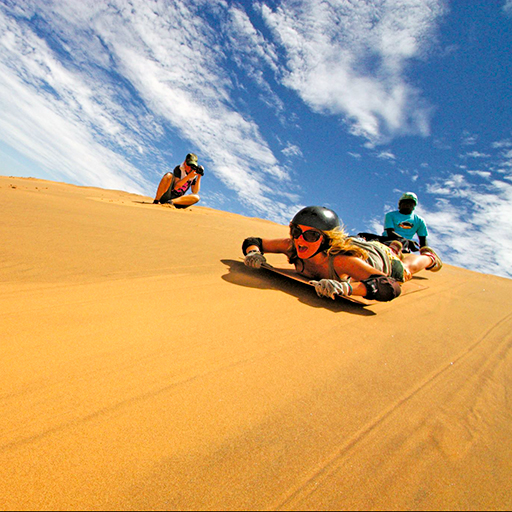
Sandwich Harbour
Sandwich Harbour, Namibia: A Breathtaking 4x4 Adventure Between Dunes & Ocean
Sandwich Harbour, located just south of Walvis Bay in Namibia, is one of the most stunning coastal landscapes in the world. This remote and dramatic destination—where towering sand dunes meet the Atlantic Ocean—is accessible only by 4x4 vehicle or guided tour, making it a thrilling adventure for nature lovers, photographers, and explorers.
Why Visit Sandwich Harbour?
- UNESCO World Heritage Site – Part of the Namib Sand Sea.
- Stunning Scenery – Dunes up to 100 meters high plunge directly into the ocean.
- Rich Wildlife – Home to flamingos, pelicans, seals, and jackals.
- Exclusive Access – Only reachable with a 4x4 or guided tour due to extreme tides and soft sand.
Best Ways to Explore Sandwich Harbour
1. Guided 4x4 Excursions
The most popular (and safest) way to visit is on a guided 4x4 tour from Walvis Bay or Swakopmund. Expert drivers navigate the shifting sands and tidal flats, providing:
- Dune driving – Heart-pounding climbs and descents.
- Scenic viewpoints – Panoramic stops for photography.
- Wildlife sightings – Flamingos, dolphins, and desert-adapted creatures.
- Historical insights – Learn about the area’s shipwrecks and early fishing industry.
2. Self-Drive (For Experienced Off-Roaders Only!)
If you have a 4x4 with low-range capability, you can attempt the drive—but only with proper preparation:
- Check tide times (high tide blocks access).
- Deflate tires for soft sand traction.
- Bring recovery gear (shovel, tow straps).
- GPS or local guide recommended—navigation is tricky!
3. Scenic Flights & Drone Photography
For a bird’s-eye view, book a scenic flight from Walvis Bay. The aerial perspective showcases the stark contrast between dunes and ocean, making for incredible photos.
Wildlife & Birdwatching
Sandwich Harbour is a haven for birdlife, especially:
- Greater & Lesser Flamingos (thousands gather in the lagoon).
- Pelicans, Cormorants, and Oystercatchers.
- Seals & Dolphins (often spotted near the shoreline).
- Desert-adapted creatures like jackals and lizards.
Best Time to Visit
- Morning Tours – Best light for photography, calmer winds.
- Low Tide – Ensures beach access (tides can cut off the route).
- April–November – Cooler temperatures, peak bird migrations.
What to Bring
- Camera & binoculars (wildlife and landscapes are spectacular).
- Sunscreen, hat, and sunglasses (reflection off sand is intense).
- Windbreaker/jacket – Coastal winds can be chilly.
Safety Tips
✔ Never go alone – Always travel with a guide or experienced off-roader.
✔ Respect the tides – Many vehicles have been lost to rising water.
✔ Stay on marked paths – Protects fragile ecosystems.
Final Thoughts
A Sandwich Harbour excursion is a must-do adventure in Namibia, offering a rare blend of desert, ocean, and wildlife in one breathtaking location. Whether you choose a guided 4x4 tour, scenic flight, or daring self-drive, this unforgettable journey will leave you in awe of nature’s raw beauty.
Ready to explore? Book your Sandwich Harbour adventure today!
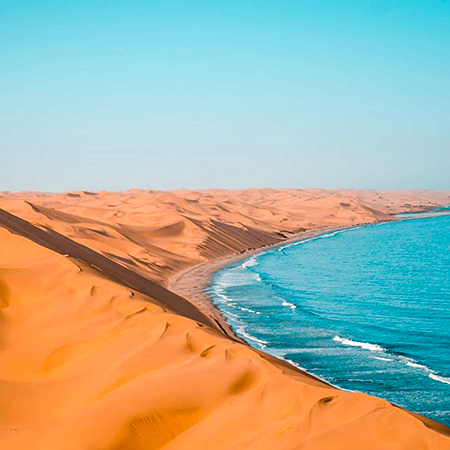
SossusVlei - Sesriem
Sossusvlei, Deadvlei & Sesriem: Exploring Namibia’s Iconic Desert Wonders
Deep in the heart of the Namib Desert, the Sossusvlei, Deadvlei, and Sesriem Canyon form one of Namibia’s most breathtaking landscapes. With towering red sand dunes, eerie white clay pans, and a dramatic canyon, this UNESCO World Heritage Site is a must-visit for adventurers, photographers, and nature lovers.
Why Visit Sossusvlei, Deadvlei & Sesriem?
- Some of the tallest dunes in the world (Big Daddy reaches 325m!)
- Surreal scenery – The contrast of red dunes, white clay, and blue sky is unforgettable.
- Unique desert wildlife – Oryx, lizards, and desert-adapted beetles.
- Stargazing paradise – Minimal light pollution for incredible night skies.
1. Sossusvlei – The Crown Jewel of the Namib
A clay pan surrounded by massive dunes, Sossusvlei is the most famous attraction in the Namib-Naukluft Park.
Best Experiences:
- Climb Dune 45 – A star dune known for its perfect shape, best at sunrise.
- Conquer Big Daddy – The tallest dune (325m) with a thrilling descent into Deadvlei.
- 4x4 Adventure – The last 5km to Sossusvlei is deep sand—only 4x4s allowed (shuttle available)
2. Deadvlei – The Ghostly White Clay Pan
One of the most photographed places in Africa, Deadvlei is a surreal white pan with ancient dead camel thorn trees (over 900 years old!) against a backdrop of red dunes.
Best Experiences:
- Sunrise Photography – Golden light illuminates the dunes and dead trees.
- Walk Among the Skeletons – Wander between the blackened, sun-scorched trees.
3. Sesriem Canyon – A Hidden Desert Oasis
Carved by the Tsauchab River, this narrow canyon (about 1km long and 30m deep) offers shade and occasional water pools.
Best Experiences:
- Short Hike – Explore the canyon’s twists and turns (easy to moderate).
- Cool Off – If water is present, take a refreshing dip.
Best Time to Visit
- Sunrise (4:30-6 AM) – Best for photography, cooler temperatures.
- Sunset (5-6:30 PM) – Stunning golden hues on the dunes.
- April–October – Pleasant daytime temps (20-25°C), cold nights.
- Summer (Nov–Mar) – Extremely hot (over 40°C), less comfortable for hiking.
Essential Tips for Your Visit
- Enter Early – Gates open at sunrise (5 AM in summer, 6:30 AM in winter).
- Wear Closed Shoes – Sand gets extremely hot by mid-morning.
- Pack a Headlamp – If arriving before dawn for sunrise.
- Respect the Environment – No drones without permits, stay on marked paths.
Final Thoughts
Sossusvlei, Deadvlei, and Sesriem Canyon are must-see destinations in Namibia, offering some of the most stunning desert landscapes on Earth. Whether you climb dunes at sunrise, wander through the ghostly Deadvlei, or explore the hidden depths of Sesriem Canyon, this adventure will stay with you forever.
Ready to explore? Plan your trip to Namibia’s desert wonderland today!

Cape Cross - Skeleton Coast
The Skeleton Coast: Namibia's Mysterious & Untamed Wilderness
Stretching along Namibia’s northern Atlantic shoreline, the Skeleton Coast is one of the most hauntingly beautiful and desolate places on Earth. Named for the shipwrecks and whale bones that litter its shores, this remote coastline is a land of extremes—where the Namib Desert meets the frigid Atlantic Ocean, creating a surreal and unforgettable landscape.
Why Visit the Skeleton Coast?
- Shipwrecks & Ghostly Remains – Explore abandoned vessels stranded in the sand.
- Wildlife Wonders – Seals, desert-adapted lions, and rare birds thrive here.
- Dramatic Landscapes – Rolling dunes, rocky outcrops, and eerie fog banks.
- Exclusive Adventure – One of the least-visited yet most captivating places in Africa.
Top Attractions & Must-Do Experiences
-
Shipwrecks of the Skeleton Coast
- The coastline is littered with rusting ship remains, some centuries old, slowly being reclaimed by the desert. Famous wrecks include:
- Eduard Bohlen (1909) – A ghostly shipwreck now stranded far inland due to shifting sands.
- Zeila (2008) – A more recent wreck near Henties Bay, popular for photography.
-
Cape Cross Seal Colony
- Home to over 100,000 Cape fur seals, this is one of the largest seal colonies in the world. The sight (and smell!) is overwhelming, but watching playful pups and predator attacks by jackals is unforgettable.
-
Clay Castles & Hoarusib River Wildlife
- Desert-adapted elephants
- Brown hyenas
- Rare birds like the Damara tern
- The clay formations of the Hoarusib River resemble ancient castles, while the riverbed is a hotspot for:
-
Skeleton Coast National Park
- The Ugab River "Moon Landscape" – A bizarre, eroded terrain.
- Roaring Dunes – Some dunes "sing" when the wind blows.
- Himba Tribe Encounters – Meet Namibia’s iconic semi-nomadic people.
- Accessible only by fly-in safari or guided 4x4 expedition, this restricted area is where the true wilderness begins. Highlights:
Best Time to Visit
- May–October (Dry season) – Cooler temps, best wildlife viewing.
- June–August – Thick fog rolls in, adding to the eerie atmosphere.
- November–April – Extreme heat, less accessible.
How to Explore the Skeleton Coast
-
Self-Drive (4x4 Required)
- Permits needed for the National Park.
- Only recommended for experienced off-roaders—fuel and supplies are scarce.
- Best route: Swakopmund → Torra Bay → Terrace Bay (limited access beyond).
-
Guided Expeditions
- Multi-day 4x4 safaris
-
Scenic Flights
- Day trips from Swakopmund or Windhoek.
- Charters to remote airstrips for exclusive stays.
Essential Travel Tips
- Permits Required – Book in advance for the National Park.
- Fuel & Supplies – Fill up in Swakopmund or Henties Bay; no services beyond.
- Pack Warm Layers – Coastal winds are cold, even in summer.
- Respect the Environment – No drones, stay on designated paths.
Final Thoughts
The Skeleton Coast is not just a place—it’s an experience. From its shipwrecks and roaring dunes to its seal colonies and desert elephants, this is raw, untamed Africa at its most dramatic. Whether you explore by 4x4, air, or guided safari, prepare for a journey like no other.
Ready to brave the Skeleton Coast? Start planning your adventure today!

Visa & Travel Information
Click Image for more info
Visa Requirements
Which Countries Require a Visa for Namibia? (Updated 2025)
Travelers from the following countries must apply for a tourist visa when entering Namibia:
Africa:
Benin, Burkina Faso, Burundi, Cabo Verde, Cameroon, Central African Republic (CAR), Chad, Comoros, Cote d'Ivoire, Djibouti, Equatorial Guinea, Eritrea, Gabon, Gambia, Ghana, Guinea, Guinea-Bissau, Liberia, Madagascar, Mauritania, Niger, Rwanda, Sao Tome & Principe, Sierra Leone, Togo, Tunisia, Uganda, Western Sahara Republic.
Americas:
Argentina, Canada, Chile, Mexico, Nicaragua, Paraguay, Peru, United States, Uruguay, Venezuela.
Asia & Middle East:
Armenia, Azerbaijan, Cambodia, Israel, Japan, Kazakhstan, Kyrgyzstan, Singapore, South Korea, Tajikistan, Thailand, Turkmenistan, Turkey, United Arab Emirates, Uzbekistan, Vietnam.
Europe:
Austria, Belarus, Belgium, Bulgaria, Croatia, Czech Republic, Denmark, Estonia, Finland, France, Germany, Greece, Hungary, Iceland, Ireland, Italy, Latvia, Liechtenstein, Lithuania, Luxembourg, Moldova, Netherlands, Norway, Poland, Portugal, Romania, Russia, Slovakia, Spain, Sweden, Switzerland, Ukraine, United Kingdom, Vatican City.
Oceania:
Australia, New Zealand.
Costs for a Visa
- Non-African Citizens: 1,600 NAD (~$90 USD / €80)
- African Citizens: 1,200 NAD (~$70 USD / €60)
How to obtain a Visa
You have two options:
- Visa on Arrival
- Pros: Simple process, pay by credit card at the immigration counter.
- Cons: May cause slight delays at entry.
- Online Pre-Application (E-Visa)

Travel Tips & Information
Start Your Namibian Adventure Today!
Whether you're seeking solitude in the desert, thrilling wildlife encounters, or cultural immersion, Namibia promises an extraordinary journey.
Book your trip now and experience the magic of Africa’s hidden gem!
Best Time to Visit
- May – October (Dry Season) – Ideal for wildlife viewing in Etosha and comfortable temperatures.
- November – April (Wet Season) – Lush landscapes and birdwatching opportunities, though some areas may be harder to access.
- Pack for all weather conditions – hot days and chilly nights are common.
Speed Limits & Road Safety
- Urban areas: 60 km/h
- Surfaced roads (outside towns): 120 km/h
- Gravel roads (outside towns): 100 km/h *(recommended to drive 60–80 km/h for better control)*
Key Driving Rules in Namibia
- Drive on the left side of the road.
- Seatbelts are mandatory for all passengers (front and back).
- Always use headlights, even during the day.
- Carry a valid driver’s license when operating a vehicle.
Wildlife & Night Driving
- Animals frequently cross roads—stay alert, especially at dusk and dawn.
- Avoid driving at night—wildlife activity increases collision risks.
- In game reserves:
- Follow park safety guidelines.
- Never exit your vehicle near wild animals.
- Observe animals only from inside your car.
Respect & Environmental Care
- Dispose of litter responsibly.
- Respect local communities and cultures, especially in rural areas.
General Safety Tips
- Secure valuables—don’t leave them visible in your car or hotel room.
- Lock your hotel room when entering or leaving.
- Avoid carrying large amounts of cash.
- Do not pick up hitchhikers.
- Keep cameras and jewelry discreet to avoid attracting attention.
